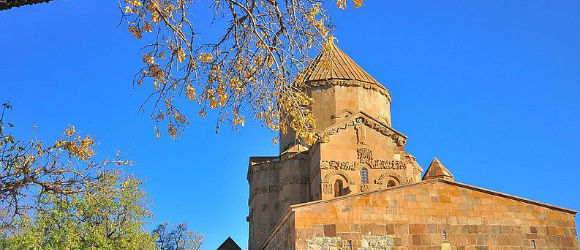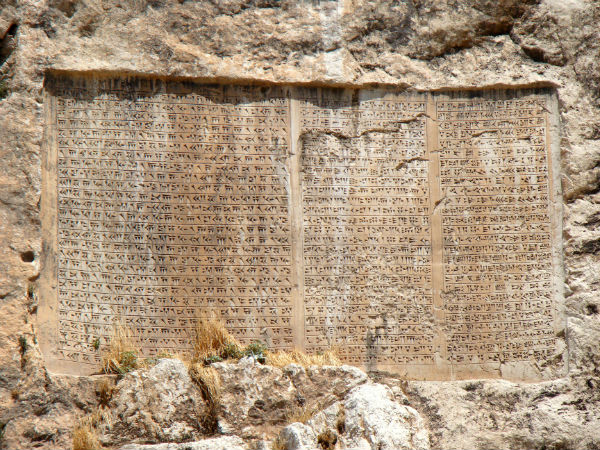Van was once the center of the Kingdom of Urartu; it was known as Tushpa. It is located on the eastern shore of Lake Van in eastern Turkey. It became the center of an Armenian kingdom founded by Tigranes the Great in the first century B.C. There is a great citadel there which one should visit.
Nearby, in Gevaş which is about 35 kilometers southwest of Van, one can hire a boat to the little island of Ahtamar where there are Impressive ruins of a tenth century Armenian church. The outside walls of the church are decorated with designs and bas-reliefs of biblical scenes such as Adam and Eve, David and Goliath, and Jonah. A number of other similar Christian churches are in this area.
Van,




The Akdamar Church on a island in Van Lake (locals call it the Van Sea) is an attractive spot for Orthodox Christians. Restoration studies have clearly improved the site but there is much more to do for visitors. Boats leave from the main island at every 20 minutes. The price of the boat is 10 TL two ways. The cafe…
The church is lovely, even is the Turkish autorities could do more to refresh it. And it's possible to take a swim after visit.
Surprising salty lake in the middle of mountains. Don't forget your swimsuit
This is a "must see". The island is set in the blue of Lake Van and is a very peaceful and scenic oasis. The perfect place for a picnic or a restful time away from it all.
When you arrive akdamar island in gevaş, you need to get on a ship. The ship departs when it is full. So you can wait one hour or one minutes. You need to know it. The price is 15 tl for two ways.
Okay it might not be the easiest place to reach but it is well worth the effort. This is my experience to Akdamar Island from Van. The first thing I did was to go to the Tourist Office and obtained a brochure for the Akdamar Kilisesi. They don't have anything in (or speak) English, but a brochure might help your…
The church and Akdamar Island go hand in hand. The island provides the backdrop for the church which sits on the island like a baby kitten in your hand. A "must see" attraction if you are in the area.
Amazing and totally unique (to this Australian at least) perfectly preserved Armenian reliefs (but very vivid) all around the outside of the church and a cute trip out to the island too. The frescoes were good but not like what you can see in eg. Cappadocia.
I went with Sabahattin from Alkan tours, in addition to Hosap and Van Castle/a…
Van Castle
Nothing is quite so impressive in Van as the Van Castle, which dominates the view of the city. About 3km west of the city centre, it’s a wonderful place to come for a picnic.
Just past the spot where the minibus drops you, on the northern side of the rock, is a modern mosque and the tomb of Abdurrahman Gazi, a Muslim holy man. It’s frequently visited by pilgrims including infertile women who are thought to be helped by coming here. Further on, at the northwestern corner, you’ll reach the ticket office, then the car park, where there are toilets and a tea garden.
A stairway from the car park leads up the rock. Once you’ve reached the summit, the old city reveals itself like Pandora’s box. Over towards the southern face of the rock you’ll see an iron gateway blocking off a lengthy cuneiform inscription. This recounts the high points of King Argishti I’s reign (786-764 BC). There are also several rock-cut funeral chambers, including King Argishti’s.
Continue up to the top of the rock, where you can see the fortifications, including the Sardur Burcu (Sardur Tower, 840-830 BC) with several cuneiform inscriptions in Assyrian praising the Urartian King Sardur I.
If you look down to the south of the rock, you’ll see a flat space broken up by the grass-covered foundations of numerous buildings. This was the site of Tushpa, an Urartian city that flourished almost 3000 years ago, although the foundations you see are those of the old city of Van, destroyed during the upheavals of WWI. Time is well spent walking around the base of the rock afterwards and inspecting these ruins, preferably taking someone to guide you for safety and avoid potential hassles from kids. Of the Seljuk Ulu Cami only a broken brick minaret remains, but the Hüsrev Paşa Külliyesi, dating back to 1567, has been restored and you may be able to get inside to see the fine brick dome and fragmentary murals. If not, you can still inspect the delicate kümbet (tomb) attached. The nearby Kaya Çelebi Camii (1662) has a similarly striped minaret but is still in use and likely to be locked except at prayer times.
Van Museum
This compact museum was closed at the time of writing following the 2011 earthquakes, and a potential move to near Van Castle was also rumoured. Check at the tourist information office for the latest update.
The museum boasts an outstanding collection of Urartian exhibits, including exquisite gold jewellery, and an array of bronze belts, helmets, horse armour and terracotta figures.
The ethnographic exhibits upstairs include local Kurdish and Turkoman kilims and a carpeted sitting area, such as is found in village houses. The Genocide Section is a piece of one-sided propaganda displaying the contents of graves left from the massacres of Turks and Kurds by Armenians at Çavuşoğlu and Zeve.